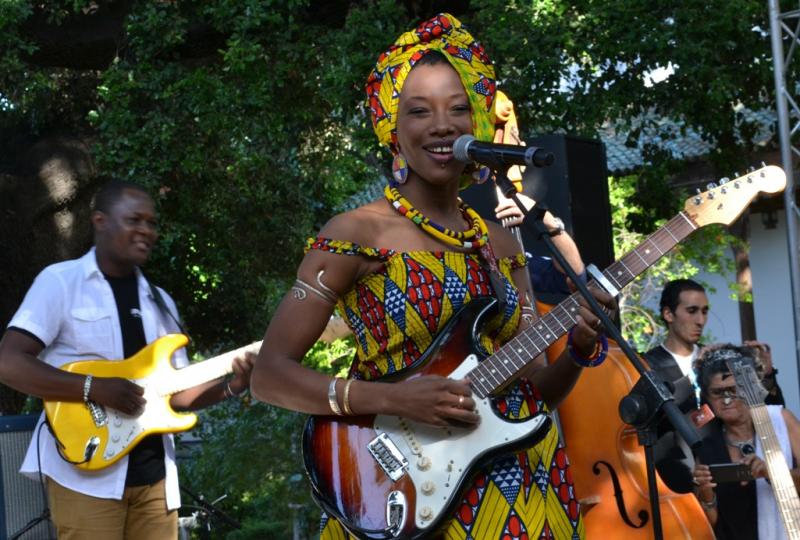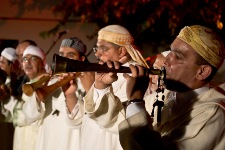theartsdesk in Fes: Has the magic gone? | reviews, news & interviews
theartsdesk in Fes: Has the magic gone?
theartsdesk in Fes: Has the magic gone?
The top world music festival reinvents itself with an Africa theme

More than anywhere else, the Fes Festival of World Sacred Music has been the place where I have gone annually for most of the last 20 years to retune my ears, to find inspiration and connections, and to discover new international music. For fans, it was always more than a mere music festival; there was a visionary, idealistic element.
Fes itself is in many ways the star of the show – the ancient medina with the winding car-free streets, the call of the muezzin, the circling swallows in the Bab Boujloud at sunset. Last year Skali and many of his associates were pushed out and so the big question for fans of the festival centred on how it was being remade, and would the idealistic elements remain? Skali, incidentally, still runs an impressive Sufi festival in Fes earlier in the year.
The printed programme was a disappointment – no mention of what many people see as the heart of the festival: the Sufi nights where followers of the local Sufi brotherhoods perform outside, very late, in Dar Tazi; no mention of the Festival of the City, which are the free concerts in Bab Boujloud (the big concerts are very expensive for most ordinary locals); and no mention of Skali himself, which seemed at best a faux pas, at worst rude and ungrateful. Fortunately, the excellent local blog The View from Fez kept us up to speed with the programme.
One great thing about Fes is the characters you meet, which illustrates the sheer strangeness of the place
I arrived in a unseasonal, torrential rainstorm and that night's concert of the always feisty Oumou Sangare from Mali was cancelled. But the following day I saw three top-notch shows which assuaged fears that the musical level might have gone down. There was an extraordinary and moving ritual in the medina from Burkina Faso called Masks of the Moon, like some Peter Brook 1970s avant-garde production, but centuries old and compelling both visually and musically. There was a performance of Cuban pianist Omar Sosa and a wonderful, expressive dancer called Tamango with percussionist Gustavo Ovalles. Sosa is a consummate pianist who has musicality oozing out of every pore and the result was both plugged into the past in its use of Santería sacred rhythms of Cuba and modern in its presentation, with impressive video projections under the famous massive barbary oak in Musée Batha.
There was a curious but satisfying collaboration between Indian slide guitarist Debashish Bhattacharya and African kora maestro Ballaké Sissoko, both of them doing music that originated in the 13th century on different continents. These were all in the Nights In the Medina strand, which was like a delicious tapas miscellany of musics.
The music director of the festival, Alain Weber, did mention that he felt “less constrained” under the new regime and it is likely that the above selection would have been impossible in earlier years – notably the mix of dance and video projection. I went off the main programme to get my musical kicks for much of the rest of the week. Instead of seeing what were billed as US soul legends The Temptations (actually, the splinter group The Temptations Review featuring Dennis Edwards, who joined the real line-up in 1968) I ended up seeing a fabulous group from the disputed territory of Western Sahara fronted by the charismatic figure of Saida Charaf, who dominated the stage in front of thousands of revellers in Bab Boujloud.
The theme of this year’s festival was Africa and Morocco’s relationship to it, but there wasn’t any gnawa music, that most African of Moroccan of forms developed by slaves (a painful issue in itself not mentioned much at the morning discussion forum, I am told) who came over the Sahara, so I jumped at the chance of attending an all-night Iila, or healing ceremony, in the medina. The close-up funk-spiritual rhythms at Casa Zohra were thrilling but I bailed out at 4am after a traditional harira soup. I’m not necessarily blaming the soup, but I was sick the next day and only recovered after two days, and this may have flavoured my perception of the rest of the festival.
One great thing about Fes is the characters you meet, which illustrates the sheer strangeness of the place. One local guy told me how he had had a nervous breakdown and the only way out was to invent his own religion based around birds. For three months he drank bottles of water with bird feathers in as a successful cure. One could do a whole book on such characters found in Fes and their stories.
 Without Faouzi Skali and some of his friends and acolytes the festival normally attracts – the Sufi leaders, the social activists, the visionary academics – the audience seemed to consist more than preiously of curious tourists. Some of the music, excellent enough, such as the collaboration between Cuban pianist Roberto Fonseca and Malian singer Fatoumata Diawara, was the type of thing you can see at the Barbican and WOMAD and perhaps it’s too early to tell with the new set-up, but there was a feeling that the festival might be morphing into a merely a superior world music festival, with some of the old soul or magic missing. I imagine this is a familiar refrain from those who went to the early Glastonbury, Burning Man or Festivals in the Desert (“you should have been there in the early years”), even if most newcomers think they are still impressive events.
Without Faouzi Skali and some of his friends and acolytes the festival normally attracts – the Sufi leaders, the social activists, the visionary academics – the audience seemed to consist more than preiously of curious tourists. Some of the music, excellent enough, such as the collaboration between Cuban pianist Roberto Fonseca and Malian singer Fatoumata Diawara, was the type of thing you can see at the Barbican and WOMAD and perhaps it’s too early to tell with the new set-up, but there was a feeling that the festival might be morphing into a merely a superior world music festival, with some of the old soul or magic missing. I imagine this is a familiar refrain from those who went to the early Glastonbury, Burning Man or Festivals in the Desert (“you should have been there in the early years”), even if most newcomers think they are still impressive events.
Although not advertised fully, the Sufi nights at Dar Tazi were on (pictured above). The highlights were the wonderful Said Guissi, who takes traditional Aissawa music – described by one visitor in the 1920s as “a tempest of oboes and drums” – into a new place. I think of him as a kind of Miles Davis of old-style Moroccan trance music. The last night, too, was exceptional with a Hamdouchiya group featuring, unusually, a female singer and a couple of European interlopers who performed wild, off-kilter trance music to great acclaim.
The last night went out with a bang and was easily the most popular, with waiters begging me to get them in to the Emirati singer Hussain Al Jassmi, who charmed the overcrowded Bab Makina, where the old Palace walls were decorated effectively this year with gorgeous light projections. With a 20-odd piece band, he won over the local upper-middle classes (the women mainly turning up in heels and skirts as opposed to headscarfs). His big hit seemed to be “Habibi Bashaloni” about a lover who supports Barcelona football team, who will be celebrating the result of the Champions League final, no doubt.
The future of Arts Journalism
You can stop theartsdesk.com closing!
We urgently need financing to survive. Our fundraising drive has thus far raised £49,000 but we need to reach £100,000 or we will be forced to close. Please contribute here: https://gofund.me/c3f6033d
And if you can forward this information to anyone who might assist, we’d be grateful.

Subscribe to theartsdesk.com
Thank you for continuing to read our work on theartsdesk.com. For unlimited access to every article in its entirety, including our archive of more than 15,000 pieces, we're asking for £5 per month or £40 per year. We feel it's a very good deal, and hope you do too.
To take a subscription now simply click here.
And if you're looking for that extra gift for a friend or family member, why not treat them to a theartsdesk.com gift subscription?
more New music
 Album: Solar Eyes - Live Freaky! Die Freaky!
Psychedelic indie dance music with a twinkle in its eye
Album: Solar Eyes - Live Freaky! Die Freaky!
Psychedelic indie dance music with a twinkle in its eye
 Album: Night Tapes - portals//polarities
Estonian-voiced, London-based electro-popsters debut album marks them as one to watch for
Album: Night Tapes - portals//polarities
Estonian-voiced, London-based electro-popsters debut album marks them as one to watch for
 Album: Mulatu Astatke - Mulatu Plays Mulatu
An album full of life, coinciding with a 'farewell tour'
Album: Mulatu Astatke - Mulatu Plays Mulatu
An album full of life, coinciding with a 'farewell tour'
 Music Reissues Weekly: Sly and the Family Stone - The First Family: Live At Winchester Cathedral 1967
Must-have, first-ever release of the earliest document of the legendary soul outfit
Music Reissues Weekly: Sly and the Family Stone - The First Family: Live At Winchester Cathedral 1967
Must-have, first-ever release of the earliest document of the legendary soul outfit
 Album: Robert Plant - Saving Grace
Mellow delight from former Zep lead
Album: Robert Plant - Saving Grace
Mellow delight from former Zep lead
 Brìghde Chaimbeul, Round Chapel review - enchantment in East London
Inscrutable purveyor of experimental Celtic music summons creepiness and intensity
Brìghde Chaimbeul, Round Chapel review - enchantment in East London
Inscrutable purveyor of experimental Celtic music summons creepiness and intensity
 Album: NewDad - Altar
The hard-gigging trio yearns for old Ireland – and blasts music biz exploitation
Album: NewDad - Altar
The hard-gigging trio yearns for old Ireland – and blasts music biz exploitation
 First Person: Musician ALA.NI on how thoughts of empire and reparation influenced a song
She usually sings about affairs of the heart - 'TIEF' is different, explains the star
First Person: Musician ALA.NI on how thoughts of empire and reparation influenced a song
She usually sings about affairs of the heart - 'TIEF' is different, explains the star
 Album: The Divine Comedy - Rainy Sunday Afternoon
Neil Hannon takes stock, and the result will certainly keep his existing crowd happy
Album: The Divine Comedy - Rainy Sunday Afternoon
Neil Hannon takes stock, and the result will certainly keep his existing crowd happy
 Music Reissues Weekly: Robyn - Robyn 20th-Anniversary Edition
Landmark Swedish pop album hits shops one more time
Music Reissues Weekly: Robyn - Robyn 20th-Anniversary Edition
Landmark Swedish pop album hits shops one more time
 Album: Twenty One Pilots - Breach
Ohio mainstream superstar duo wrap up their 10 year narrative
Album: Twenty One Pilots - Breach
Ohio mainstream superstar duo wrap up their 10 year narrative
 Album: Ed Sheeran - Play
A mound of ear displeasure to add to the global superstar's already gigantic stockpile
Album: Ed Sheeran - Play
A mound of ear displeasure to add to the global superstar's already gigantic stockpile

Add comment